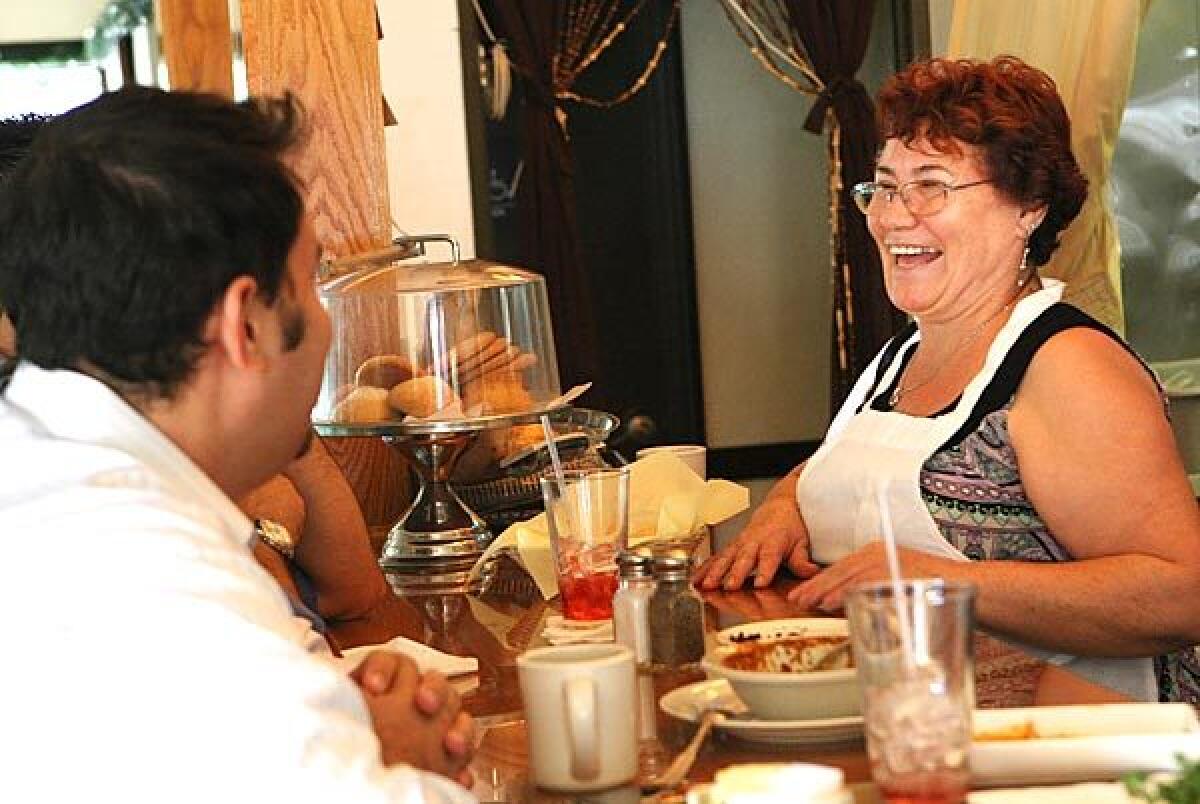The Find: Amalia’s Restaurant in L.A.

- Share via
Just north of the traffic-tangling intersection where Beverly, Temple, Virgil, Commonwealth and Silver Lake merge sits Amalia’s Restaurant. Secreted away in a refurbished bungalow on a shady stretch of Virgil, it’s a surprising oasis where Amalia Zuleta’s longtime dream, one that began with her arrival from war-torn Guatemala in 1984, is finally being realized.
The little house has been opened up to create an airy dining room. There are fine wood tables, a modest chandelier over the long service bar and specialty herbs growing outside the kitchen. On the adjacent leaf-shaded patio, tables draped with Guatemalan weavings under glass give a hint of the cuisine’s Mayan origins.
Zuleta owned a small catering company in her homeland, but here in Los Angeles, as a kitchen helper at Mi Guatemala, made little use of her skills. Later, her talents blossomed as head cook at Rinconcito Guatemalteca. There she attracted a loyal clientele that followed her when, in 1995, she opened a simple cafe (not far from her current one), Antojitos Chapines Amalia’s, which has since closed.
Those familiar with Guatemalan food won’t find Amalia’s menu unusual. It’s Zuleta’s elegant refinements, her talent for fine-tuning mole-like sauces and her selection of good ingredients that turn what is basically rustic cooking into an urbane cuisine that’s a magnet for her longtime devotees.
Take her bean purée, frijoles negros volteados, a staple that Guatemalans eat morning, noon and night. Zuleta’s has a particularly creamy, almost mousse-like quality. Her lengua en salsa, braised tongue in tomato sauce, has a silky richness that only expert handling achieves. The sauce for her pollo en crema is rich and sharp with the tang of buttery cultured cream. Perfectly caramelized fried plantains and those creamy beans garnish these and most other entrees. It’s only the plain, unbattered and unseasoned fried chicken that falls flat. It lacks the greasy deliciousness of Pollo Campero, Guatemala’s answer to the Colonel.
The pièce de résistance is the enchiladas plate. The tostada-like constructions bear no resemblance to Mexican enchiladas. Poised on a crisp fried tortilla, a hillock of hand-chopped braised beef sits under a towering topping of beet and cabbage salad. A sprinkling of aged white cheese brings salty, sweet, crunchy and meaty sensations into mind-bending harmony.
The same chopped meat goes into a chile relleno, also distinctly Guatemalan style. The roasted fresh poblano, plump and juicy, glows with a thin veneer of lightly seasoned fresh tomato sauce (and if you ask, a little thick cultured cream). Even the accompanying rice, which often seems like an afterthought in Latin restaurants, is soft and subtly luscious.
Listed nonchalantly under soups is Guatemala’s national turkey dish, kak’ik de pavo. Turkeys, indigenous to Central America, were once ceremonial offerings and this mole-like concoction is served with ceremony.
Dry-toasted chiles and spices fried with garlic and onions season the broth, in which simmers an ample chunk of fresh turkey. An accompanying platter of garnishes holds a plain, stiff tamal and rice to soak up the sauce, plus cilantro, minced onion and lime to sprinkle on for an extra fresh, punchy layer of flavor.
Amalia’s menu is long and fairly ambitious: seafood soup with fresh blue crab, mussels, shrimp and octopus; pork and white bean stew; juicy sausage flavored with mint and onions and several varieties of tamales. The bone-in chicken tamal isn’t listed but is always available.
There are marvelous breakfast plates with meats, sausages and eggs, or beans, plantains and cream. Sopa de huevo, two eggs poached in an herbal broth laced with home-grown epazote and tomato, is amazing with Amalia’s silky hand-patted tortillas. Have these with a house-made drink, an atole of sweet fresh corn or rice.
After a meal here, dessert may not call out to you, but several are more than worth a taste. The $3 rellenitos, turnovers whose “crust” is fashioned from mashed plantain filled with lightly sweetened bean purée, and a side of cream may be just enough. But not if it means skipping the sweet chocolate mole de plátano, a voluptuous chocolate-based mole darker than midnight and dancing with seeds and spices.
More to Read
Eat your way across L.A.
Get our weekly Tasting Notes newsletter for reviews, news and more.
You may occasionally receive promotional content from the Los Angeles Times.










